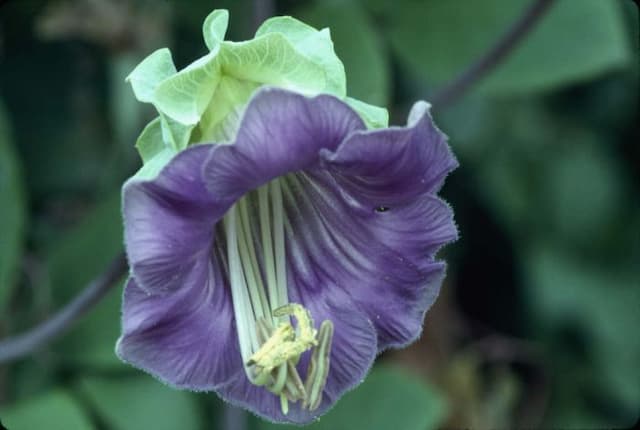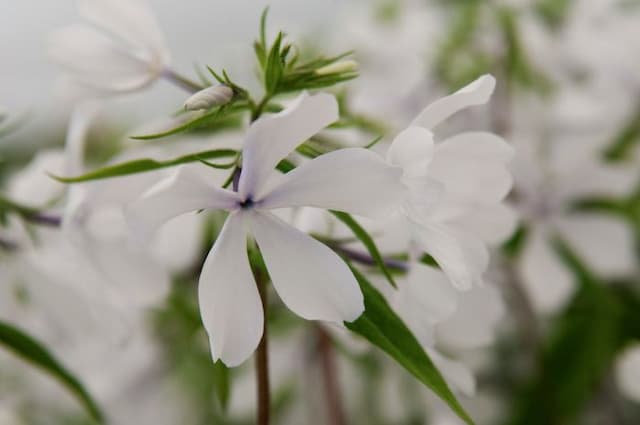Garden Phlox Phlox paniculata 'Blue Ice'

ABOUT
Phlox paniculata 'Blue Ice' is a perennial garden phlox known for its striking blooms. The plant features clusters of fragrant flowers that showcase a unique shade of pale blue with a hint of lilac undertones, giving the appearance of a cool icy tone. The flowers are composed of five-petaled florets, and each cluster forms a dome-shaped head that provides a showy display in the garden. The individual blossoms, delicate and almost transparent, exude a light, sweet fragrance that is particularly noticeable in the early morning and evening hours. The foliage of 'Blue Ice' consists of glossy, dark green leaves that are oblong with a slightly pointed tip, creating a lovely backdrop for the cool-toned flowers. The leaves are arranged oppositely on stiff, upright stems that are well-branched, supporting the generous flower heads and making the plant an ideal choice for cut-flower arrangements. Throughout its blooming period, Phlox paniculata 'Blue Ice' becomes a hub of activity, attracting butterflies, hummingbirds, and other pollinators, thanks to its nectar-rich flowers. This cultivar displays a freshness that brings a soothing palette to the garden, making it an excellent choice for borders or as a complement to other flowering plants with warmer tones.
About this plant
 Names
NamesFamily
Polemoniaceae
Synonyms
Garden Phlox, Summer Phlox, Perennial Phlox, Fall Phlox
Common names
Phlox paniculata 'Blue Ice'
 Toxicity
ToxicityTo humans
Garden Phlox is not considered toxic to humans. However, as with many plants, it is not intended for consumption, and eating it could potentially cause mild stomach upset or an allergic reaction in some individuals.
To pets
Garden Phlox is generally considered non-toxic to domestic pets such as cats and dogs. Ingestion may cause mild gastrointestinal upset, but it is not known to cause serious illness or death.
 Characteristics
CharacteristicsLife cycle
Perennials
Foliage type
Deciduous
Color of leaves
Green
Flower color
Blue
Height
2-4 feet (60-120 cm)
Spread
1-3 feet (30-90 cm)
Plant type
Herb
Hardiness zones
4
Native area
North America
Benefits
 General Benefits
General Benefits- Attracts pollinators: The flowers of Garden Phlox attract bees, butterflies, and other beneficial insects to the garden.
- Easy to grow: Garden Phlox is generally easy to cultivate in most temperate gardens with proper care.
- Long blooming period: It typically offers a long season of bloom, providing color from mid-summer through early fall.
- Colorful display: 'Blue Ice' has attractive blue-violet colored flowers that can add a unique and striking visual interest to a garden.
- Fragrant flowers: The blooms of Garden Phlox are known for their sweet fragrance, which can enhance the sensory appeal of a garden.
- Cut flower use: The stems of Garden Phlox are strong and make excellent flowers for cutting and use in indoor flower arrangements.
- Perennial growth: As a perennial plant, it returns year after year, providing long-term value in the garden.
- Drought tolerance: Once established, Garden Phlox can be quite drought-tolerant, requiring less frequent watering.
- Versatile garden use: It can be used in borders, beds, and as a backdrop for other lower-growing plants.
 Medical Properties
Medical PropertiesThis plant is not used for medical purposes.
 Air-purifying Qualities
Air-purifying QualitiesThis plant is not specifically known for air purifying qualities.
 Other Uses
Other Uses- As a natural dye: The flowers of the Garden Phlox can be used to create a natural dye for fabrics, with shades ranging from light pink to purplish depending on the mordant used.
- In potpourri: Dried Garden Phlox flowers can add a pleasant fragrance to homemade potpourri mixes.
- Educational tool: Garden Phlox can be used in school projects to teach children about pollination and the lifecycle of plants.
- Art supplies: Pressed Garden Phlox flowers can be used in creating botanical art or for decorating handcrafted greeting cards and bookmarks.
- Photography subject: With its vibrant colors, Garden Phlox makes an excellent subject for botanical photography.
- Flower arranging classes: Its sturdy stems and long vase life make it a popular choice for use in floral design and flower arranging courses.
- Garden Phlox syrup: The flowers can be used to make a floral syrup for use in gourmet cooking or to flavor cocktails and non-alcoholic beverages.
- Candle-making: The petals of Garden Phlox can be incorporated into homemade candles for a touch of natural beauty.
- Garden Phlox ice cubes: Freeze the blossoms in ice cube trays to create decorative ice cubes for special events or parties.
- Wedding decorations: The blooms can be used in wedding bouquets or as part of table centerpieces for their romantic appearance and sweet fragrance.
Interesting Facts
 Feng Shui
Feng ShuiPhlox is not used in Feng Shui practice.
 Zodiac Sign Compitability
Zodiac Sign CompitabilityPhlox is not used in astrology practice.
 Plant Symbolism
Plant Symbolism- Harmony and Unity: Phlox paniculata 'Blue Ice', commonly known as garden phlox, often represents harmony and unity due to its clustering flowers that grow together peacefully.
- Proposal and Love: Garden phlox has been a symbol of a marriage proposal or a shy confession of love, probably because of its gentle appearance and appealing fragrance.
- Sweet Dreams: In the language of flowers, garden phlox is sometimes associated with the wish for sweet dreams, possibly because they can have a soothing presence in a nighttime garden.
 Water
WaterGarden Phlox should be watered deeply once a week, providing about an inch of water each time. During hot or dry periods, increase watering to twice per week, ensuring that the soil remains moist but not waterlogged. Water at the base of the plant to keep the foliage dry and help prevent diseases. It's better to water in the morning to allow any moisture on the leaves to evaporate during the day. A total of approximately 0.5 to 1 gallon of water should be sufficient for a mature plant over the course of a week, adjusted depending on weather conditions.
 Light
LightGarden Phlox thrives best in full sun to partial shade. The ideal location is where it can receive at least six hours of sunlight each day, preferably in the morning with some afternoon shade. The plant can tolerate a bit more shade but will have fewer blooms and may become leggy.
 Temperature
TemperatureGarden Phlox is hardy and can tolerate a range of temperatures but performs best when daytime temperatures are between 65°F and 85°F. It can survive minimum winter temperatures down to -30°F. The plant begins to suffer when temperatures rise consistently above 85°F, especially when nights remain warm.
 Pruning
PruningGarden Phlox benefits from pruning to encourage bushier growth and more blooms. Deadheading spent flowers can promote a second bloom. Cut back foliage in the spring or fall to help maintain shape and size, and to remove any dead or damaged stems. It's best to prune after the main blooming period, typically the late summer.
 Cleaning
CleaningAs needed
 Soil
SoilGarden Phlox, or Phlox paniculata 'Blue Ice', thrives best in a well-draining soil mix rich in organic matter. A mixture of two parts garden soil, one part peat moss, and one part perlite or coarse sand is ideal. The soil pH should be slightly acidic to neutral, in the range of 6.0 to 7.0.
 Repotting
RepottingGarden Phlox is typically an outdoor perennial plant and does not usually require repotting. If grown in containers, repot every 2 to 3 years or when the plant outgrows its pot, using fresh soil mix as described.
 Humidity & Misting
Humidity & MistingGarden Phlox prefers average humidity levels, as it is accustomed to outdoor conditions. No particular adjustments in humidity are necessary for this plant.
 Suitable locations
Suitable locationsIndoor
Provide bright light and good air circulation for Garden Phlox.
Outdoor
Plant in sunny spot with good soil and water regularly.
Hardiness zone
4-8 USDA
 Life cycle
Life cycleThe life of Phlox paniculata 'Blue Ice', commonly known as Garden Phlox, begins with seed germination in the spring, which is often preceded by a period of stratification to break dormancy. As temperatures warm, the seeds sprout and young seedlings emerge, establishing a small rosette of leaves. As the plant grows through the season, it develops a sturdy stem and forms a clump of bright green, lance-shaped foliage. By mid to late summer, Garden Phlox reaches its flowering stage, presenting clusters of fragrant, ice-blue colored flowers which attract pollinators such as butterflies and hummingbirds. After blooming, if the flowers are not deadheaded, they will produce small capsules containing seeds that mature by fall, when the plant begins to die back as it enters dormancy for the winter. The cycle resumes the following spring when the seeds may germinate or the plant may regrow from its root system, thus continuing its perennial life cycle.
 Propogation
PropogationPropogation time
Late Summer
The most popular method of propagating Garden Phlox, specifically the cultivar Phlox paniculata 'Blue Ice', is by division. This perennial plant is typically divided in the early spring or fall. To propagate by division, one should gently dig up the entire clump of phlox once the plant has gone dormant in the fall or just before new growth starts in the spring. The clump should then be carefully separated into smaller sections, ensuring each section has a good amount of roots and a few shoots. These divisions can immediately be replanted in well-prepared soil, spaced about 12 to 18 inches (approximately 30 to 46 centimeters) apart to allow for mature spread. Water the new divisions thoroughly after planting to help establish them. This method allows the gardener to both propagate new plants and rejuvenate older clumps that may have become woody or sparse in the center.









